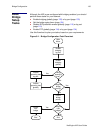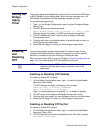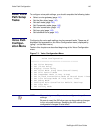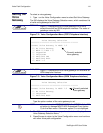
NetEngine IAD User Guide
Bridge Configuration 134
Setting the
Bridge
Aging
Timer
The bridge aging timer establishes the amount of time that the IAD keeps
a MAC address in the bridging table. When the timer reaches zero, the
IAD deletes the address from the database updates the timer.
To set the bridge aging timer:
1. Type A on the Bridge Configuration menu to select Configure Bridge
Aging Timer.
2. The IAD displays the following prompt:
Enter Bridge Aging time in seconds (1..3600): (300)
Type the aging time (range 1 to 3600 seconds) and press Enter.
3. The IAD updates the timer. Press any key to display the Bridge
Configuration menu.
4. Continue with other configuration tasks, or press Escape to return to
the Bridge Configuration menu.
5. Reset the IAD (page 15) when you finish bridge configuration.
Enabling
and
Disabling
STP
Having many bridges creates the potential for network loops. A loop
presents conflicting information about the segment on which a specific
address is located and forces the bridge to forward all data.
When configuring the IAD as a router (Chapter 4, Router Configuration on
page 103), you must disable STP both globally and by port.
Enabling or Disabling STP Globally
To enable or disable STP globally:
1. On the Bridge Configuration menu, type T to select Enable/Disable
Spanning Tree Globally.
The IAD displays the status of bridging, and a prompt:
Spanning Tree is Globally DISABLED
Enter E to Enable, D to Disable:
Type E to enable spanning tree globally, or D to disable it globally.
2. The IAD saves, then displays the Bridge Configuration menu.
3. Continue with other tasks, or press Escape to return to the Main menu.
4. Reset the IAD (page 15) when you finish bridge configuration.
Enabling or Disabling STP by Port
To enable or disable STP by port:
1. On the Bridge Configuration menu, type O to select Enable/Disable
Spanning Tree by Port.
2. The IAD displays the interfaces available on this IAD, and a prompt:
Available Interfaces:
NOTE
When you enable STP, the IAD reconfigures the bridge
network to transfer data along an optimum route to its
destination.


















